For today’s dehydrator project, we are going to dehydrate hash browns.
This is our step-by-step guide on how to dehydrate hash browns. We’re dehydrating frozen hash browns for today’s dehydration project. By using frozen hash browns, most of the hard work has already been done. The potatoes have been mechanically sliced into small matchstick-size pieces, which are ideal.
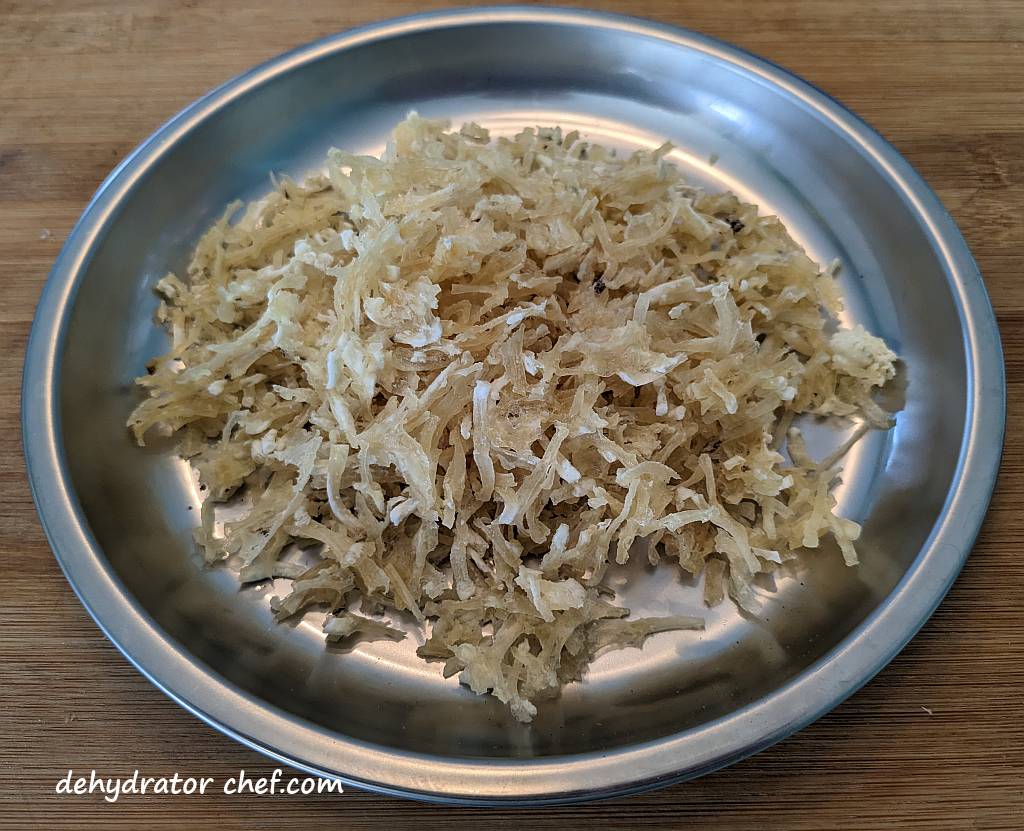
We will need to partially steam cook the hashbrowns before we dehydrate them. We’re doing this now, not out in the field or at the campsite, and we use more of our limited fuel supply than necessary.
So grab your dehydrator, and let’s get started dehydrating frozen hash browns.
How to Dehydrate Frozen Hash Browns
All you need to dehydrate these foods is a good quality food dehydrator. We use the Nesco food dehydrators. You can check out our food dehydrator guide to learn why we think Nesco offers the best bang for the buck. We believe this is the best food dehydrator for our long-term food storage needs.
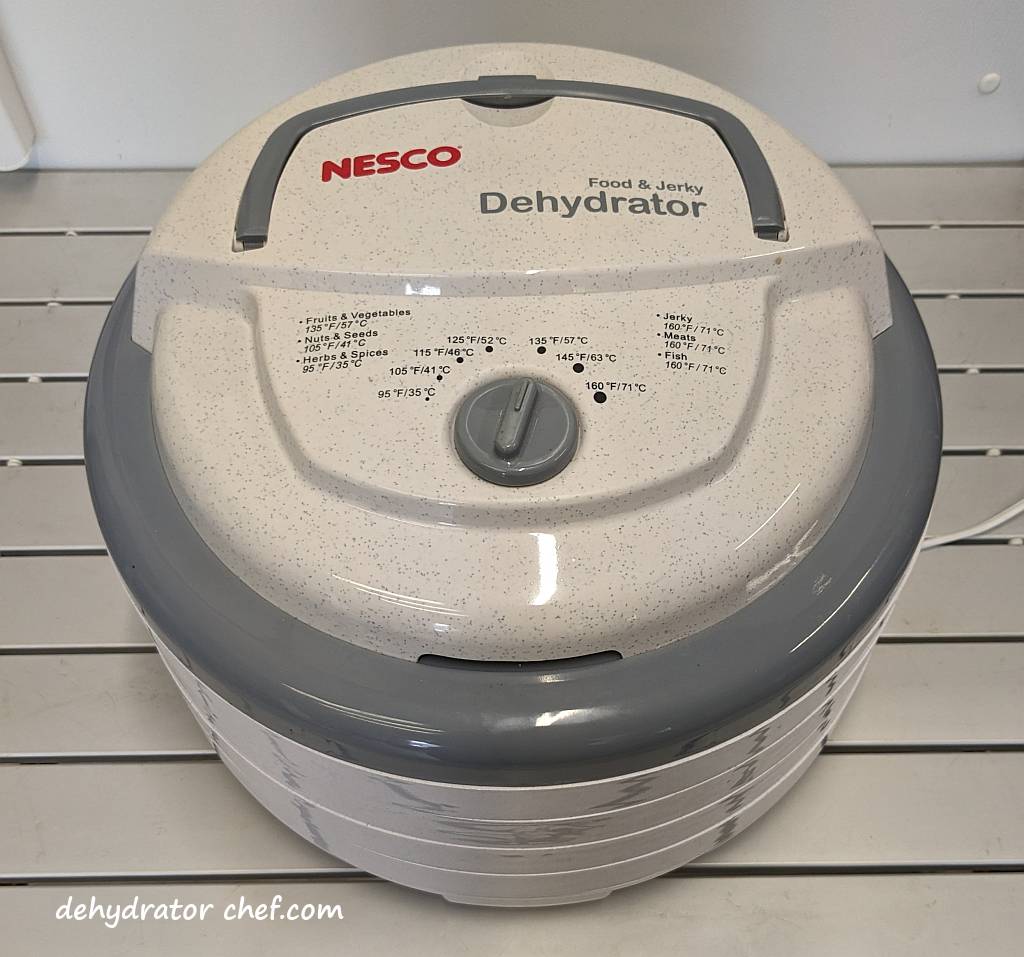
A big benefit of dehydrating already processed food is that the hard work of slicing, dicing, and shredding has already been done for you.
For planning purposes, a 30-ounce bag of frozen hash browns will fill up two to three Nesco 13.5-inch round dehydrator trays.
Supplies Needed for Dehydrating Frozen Hash Brown Potatoes
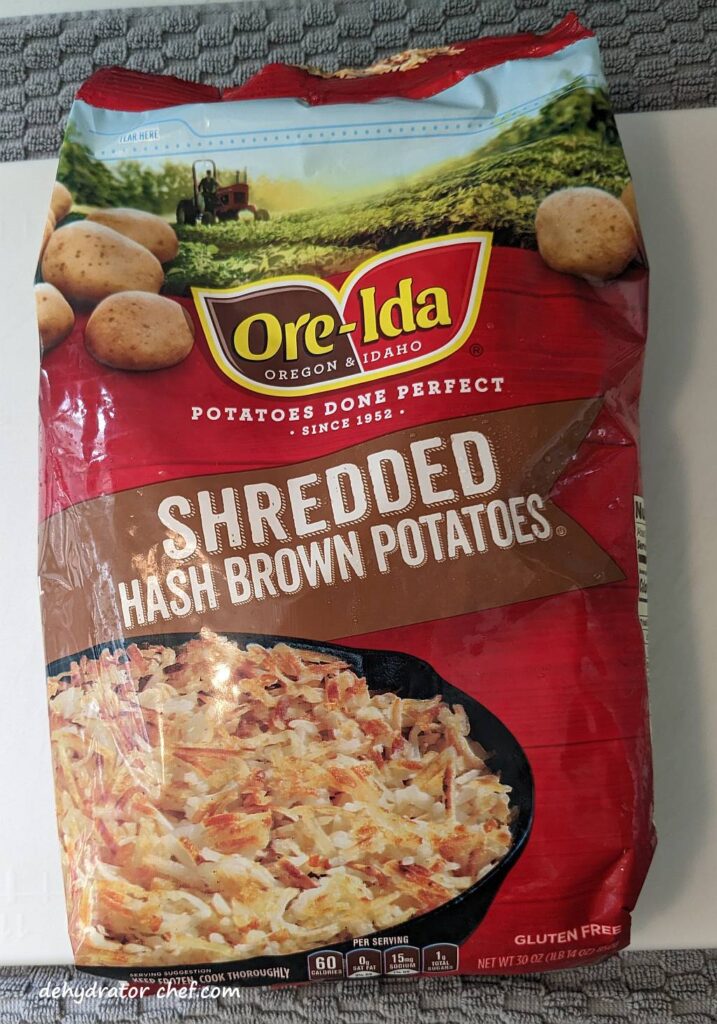
To dehydrate frozen hash browns, you’ll need the following supplies:
- A couple of bags of shredded and frozen hash brown potatoes.
- Food dehydrator
- Removable mesh screen inserts, one for each dehydrator tray
- Common kitchen tools, including cutting boards, chef’s knife, spatula, steamer basket, colander, etc.
- Canning jars with tight-fitting lids
- Wide-mouth canning jar funnel
- Desiccant packets for moisture control (optional)
Step 1. Process the Frozen Hash Browns for Dehydrating
There isn’t much to do in terms of preparing the frozen hash browns for dehydration. However, the Ore-Ida brand product label indicates that they should be cooked thoroughly.
Our Dehydrator Chef recipes mainly involve reheating and hydrating cooked ingredients. So we will want to mostly cook the shredded potatoes, but not fully cook them.
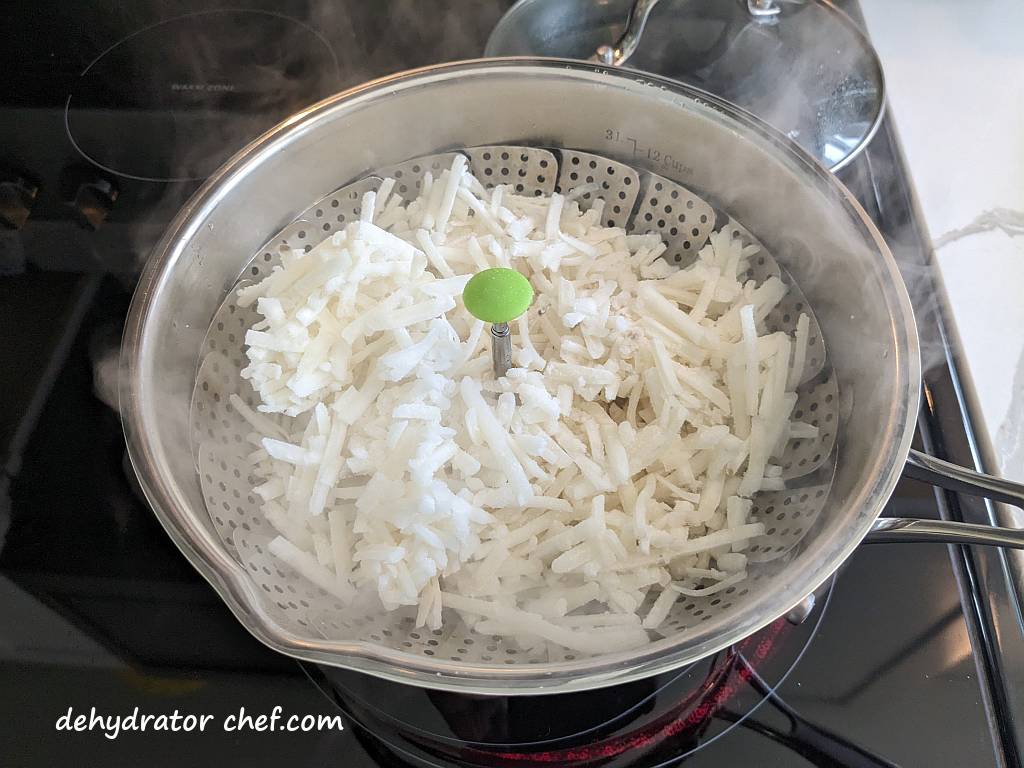
To do this, we will steam-cook the frozen hash browns for a few minutes, just enough to thaw, soften, and slightly cook the potato shreds. We’ll use a steamer basket and steam them in batches for approximately 2 minutes. After steaming, we’ll cool them in an ice bath to stop the cooking process and then drain any excess water in a colander. Do a taste test after a minute or so of steaming to gauge tenderness. We want some tenderness and also some bite left.
To begin, open the bag and place a couple of handfuls of the frozen hash browns in the steamer basket, breaking apart any large clumps. After steaming for one or two minutes, when the hash browns pass the tenderness taste test, remove the steamer basket and submerge it in the ice bath to halt the cooking. Avoid steaming them for too long, as they may become fully cooked and turn mushy.
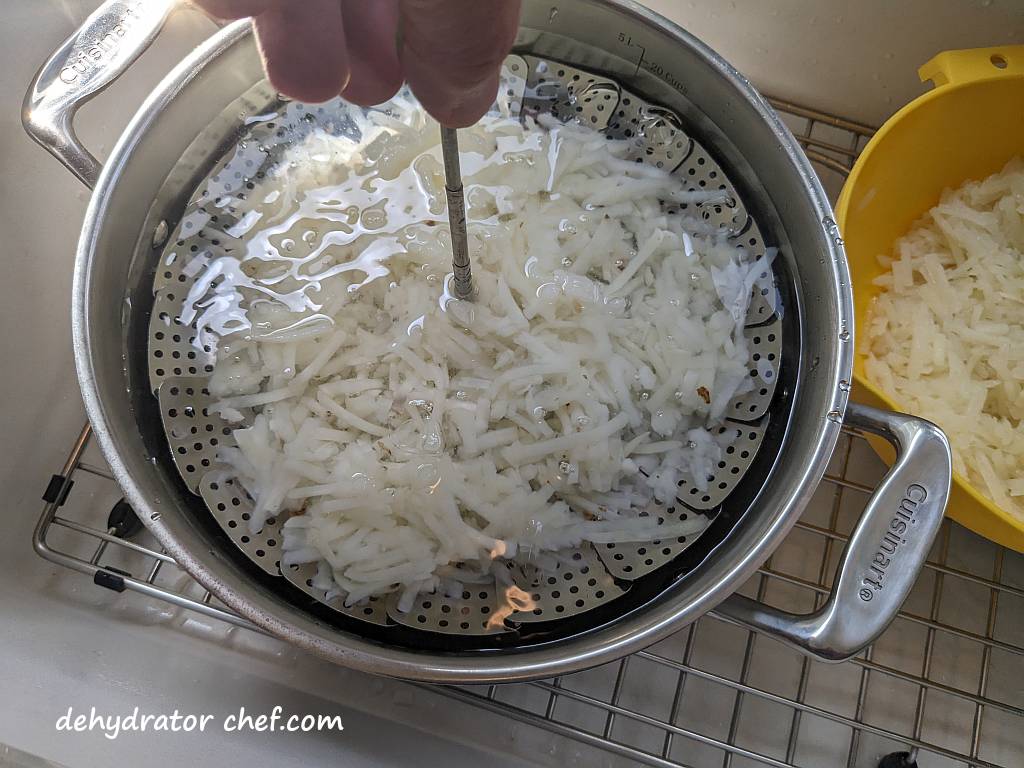
Once they have been in the ice bath, transfer the contents of the steamer basket into a colander to allow any excess water to drain.
Step 2. Preparing the Dehydrator to Dehydrate Frozen Hash Browns
One 30-ounce bag of frozen hash browns will fill two to three of my Nesco 13.5-inch round dehydrator trays with removable mesh screen inserts.
To ensure even drying, spread the drained hash browns in a thin and consistent layer on the removable mesh screen inserts. It’s important to avoid creating any clumps of hash browns, as this can lead to case hardening and uneven drying.
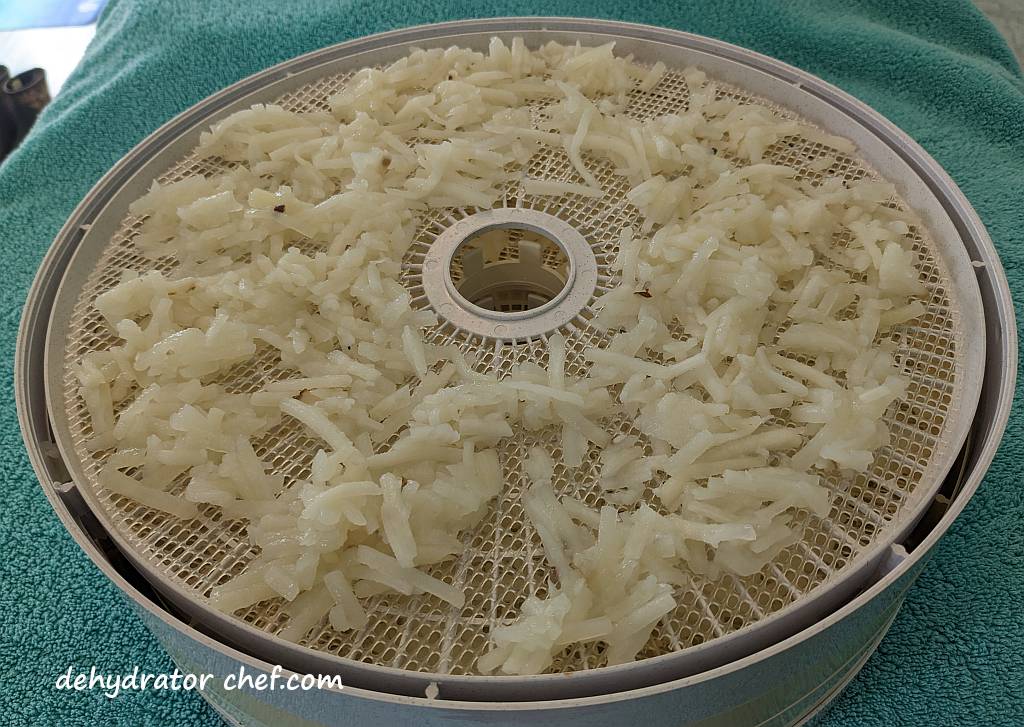
For today’s dehydrator project, we are using the Nesco Clean-A-Screen removable mesh screen inserts for sticky fruits and small food items that we are dehydrating today. They have over 2500 customer reviews with an average rating of 4.7 stars out of 5, which is evidence of a great product. Check out other Nesco food dehydrator products here.
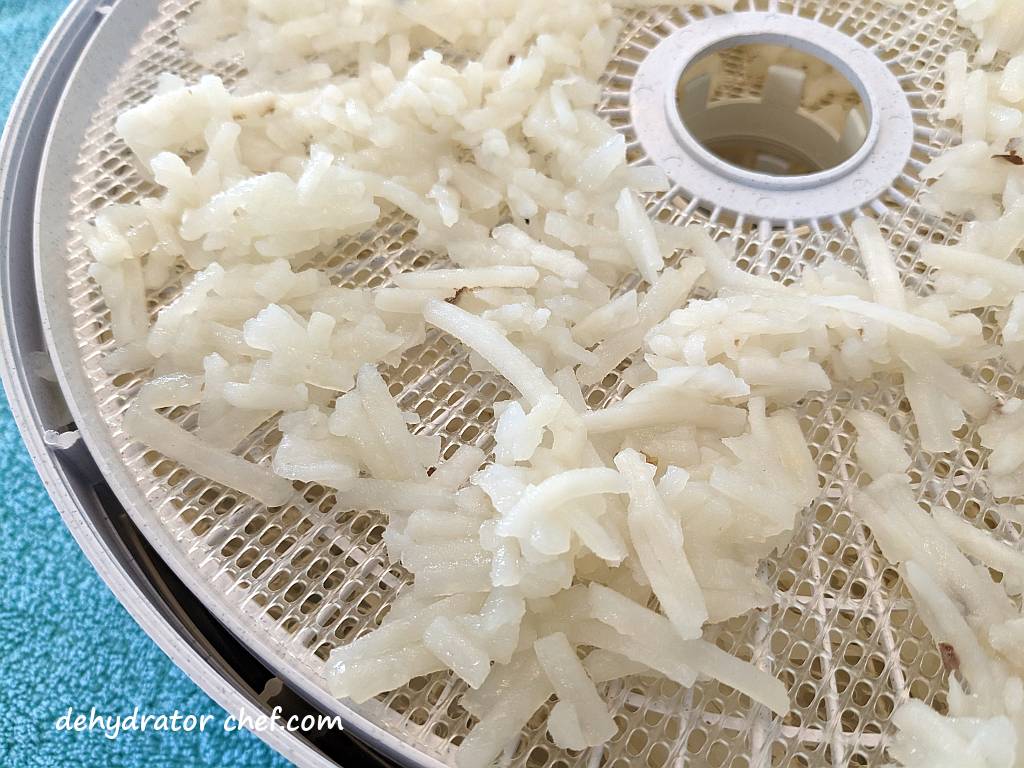
The Nesco 13.5-inch round food dehydrator tray has close to 119 square inches or .8 square feet of surface area for drying.
Step 3. Dehydrating the Frozen Hash Brown Potatoes
Begin by setting the dehydrator temperature to 135°F (57°C). Based on my experience, a drying time of 18 to 24 hours works well for dehydrating hash browns.
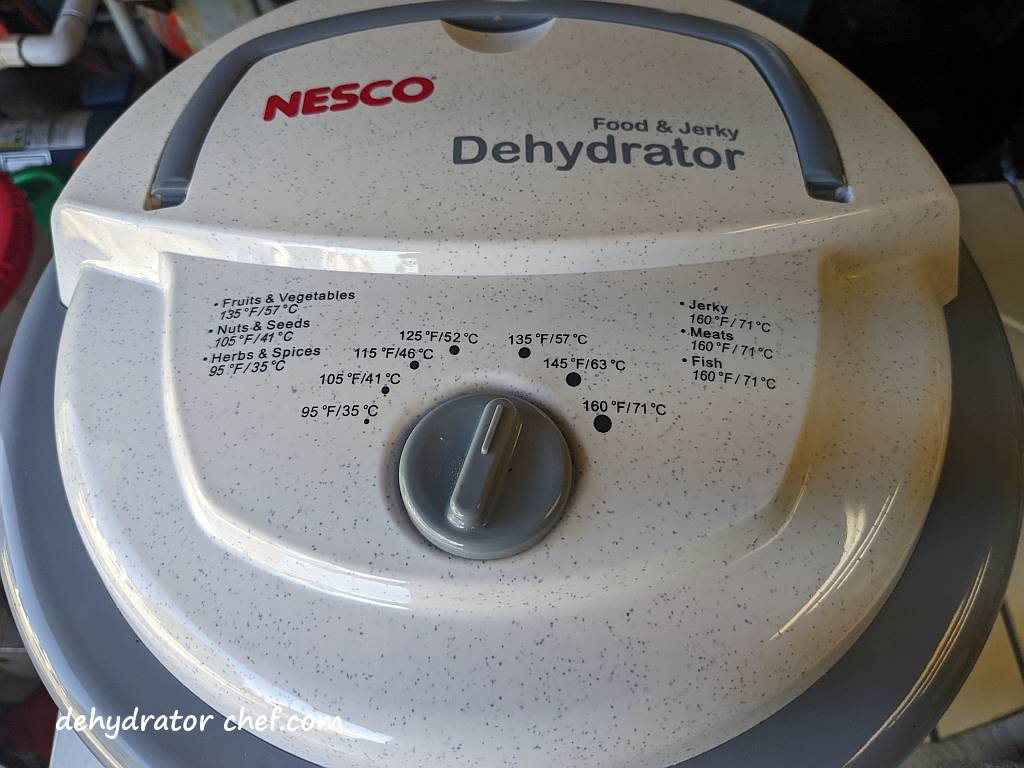
Remember to use drying times only as a guide. Of course, drying times are variable and dependent on the ambient temperature and humidity, how many trays, and how crowded or thickly you layer food into your dehydrator trays.
The outer layer of a big hash brown potato clump may dry quickly and prevent the inside moisture from escaping, otherwise known as case hardening.
Case hardening is a phenomenon that can occur during the drying process of certain foods. It refers to the development of a hard outer crust or surface layer on the food, which can prevent the escape of moisture from the interior. This can lead to uneven drying and potentially result in moisture retention.
To prevent case hardening, it’s recommended to break apart any clumps into smaller pieces approximately 45 minutes to an hour after starting the dehydrator. This will help ensure that the moisture inside the hash browns can escape evenly during the dehydration process.
Step 4. When are the Dehydrated Hash Brown Potatoes Done
After 18 to 24 hours, the hash browns should be fully dehydrated. If not, let it go another 2 or 4 hours and check again.
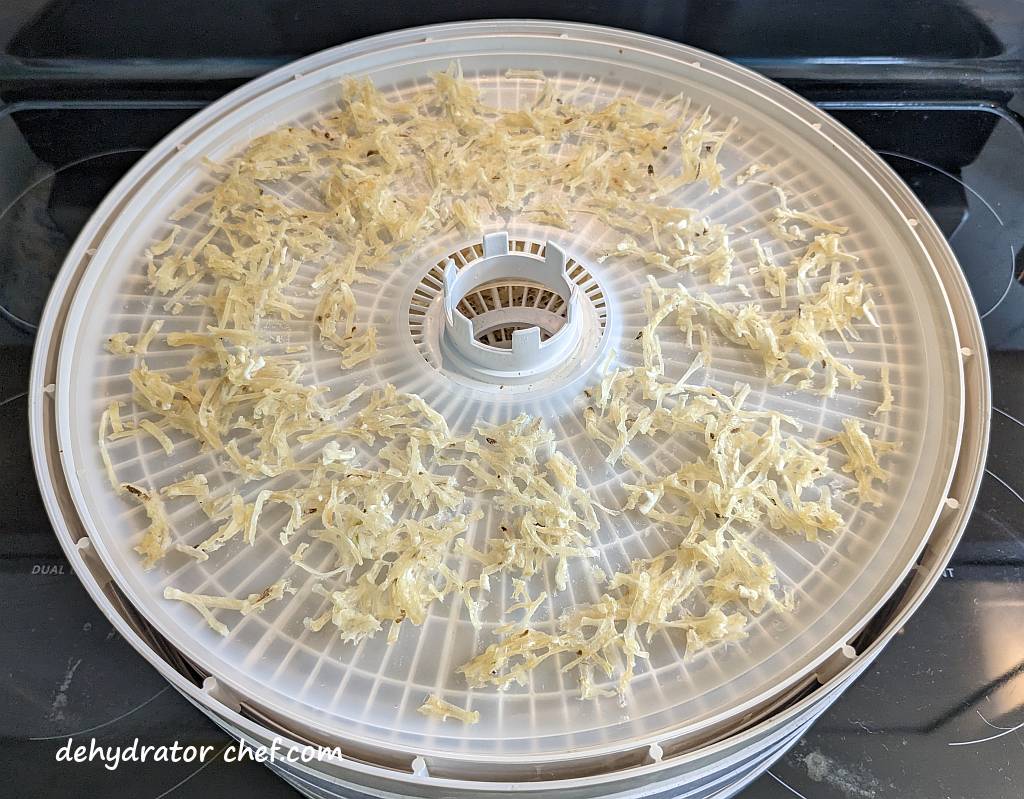
The dehydrated hash browns are done when they easily crumble. Warm hash browns still in the food dehydrator may feel somewhat bendy, and you may believe they need more drying time. Simply unplug the dehydrator and let everything cool down. Then check again to be sure. The dried potato pieces are brittle and should easily crush and crumble into smaller pieces.
Drying times will vary depending on your dehydrator. Refer to your dehydrator owner’s manual for recommended temperatures and times for dehydrating specific foods. Remember to use drying times as a guide.
Any clumps should have already been broken down into smaller pieces. If any remain, break them apart, detecting for case hardening. Continue dehydrating until it’s all done.

With experience, you will develop a sense for identifying case hardening. In the meantime, it’s recommended to thoroughly check for dryness before considering the hash browns completely done.
Step 5. Equalizing and Conditioning of the Dehydrated Hash Browns
When the dehydrated food pieces are removed from the dehydrator, the remaining moisture may not be distributed equally among the pieces because of their location and position in the dehydrator. Equalizing and conditioning is a process for freshly dehydrated foods that ensures any residual moisture remaining in any piece is spread or equalized among all the other pieces in the batch. Let the dried hash browns equalize and condition in the storage container for 7 to 10 days.
We always recommend letting food items cool completely after they have finished dehydrating and before packing them into an airtight storage container for equalizing and conditioning. Warm food may cause sweating which could provide enough moisture for mold to grow.
It does not take long for dehydrated food items to start hydrating from ambient household humidity. Do not leave dehydrated food items exposed to the elements any longer than necessary because of the increased risk of mold growth.
After a brief cooling period, loosely pack the dehydrated hash brown pieces into a clean, dry, insect-proof, and air-tight storage container.
Avoid crushing or mashing the dehydrated food if it doesn’t fit into a single jar. Instead, opt for a larger jar or use additional jars. If you frequently dehydrate food in large quantities, consider investing in larger canning jars to prevent over-packing and crushing food items. Ample space inside the jar allows for mixing, rolling, and thorough examination of the contents for any potential mold formation during the conditioning process. Since the canning jars are clear, it’s easy to see what’s inside.
A wide-mouth canning jar funnel is handy for the task of getting dehydrated food from the trays into the canning jars with minimal spillage. It’s not a necessity, but having one does make the job easier and faster. If you need one, check them out on Amazon.
Every day, check the jar for moisture. Roll the jar contents around and note any clumping or sticking. If seen, put the contents back on the dehydrator for several more hours. Since canning jars are clear, it’s easy to see what’s inside.
If you notice any mold, even the smallest bit, throw it all out. What you see are the mold spores finally blooming enough to make them visible. But there are more, even tinier mold spores in the rest of your jar that make your dehydrated food inedible. Toss it out and start another batch.
Step 6. Storing Dehydrated Hash Browns
Use an appropriately sized canning jar for storage. The dehydrated hash browns might keep up to 12 months or longer. Exactly how long depends on how well you dehydrate and condition the hash browns and your pantry storage conditions.
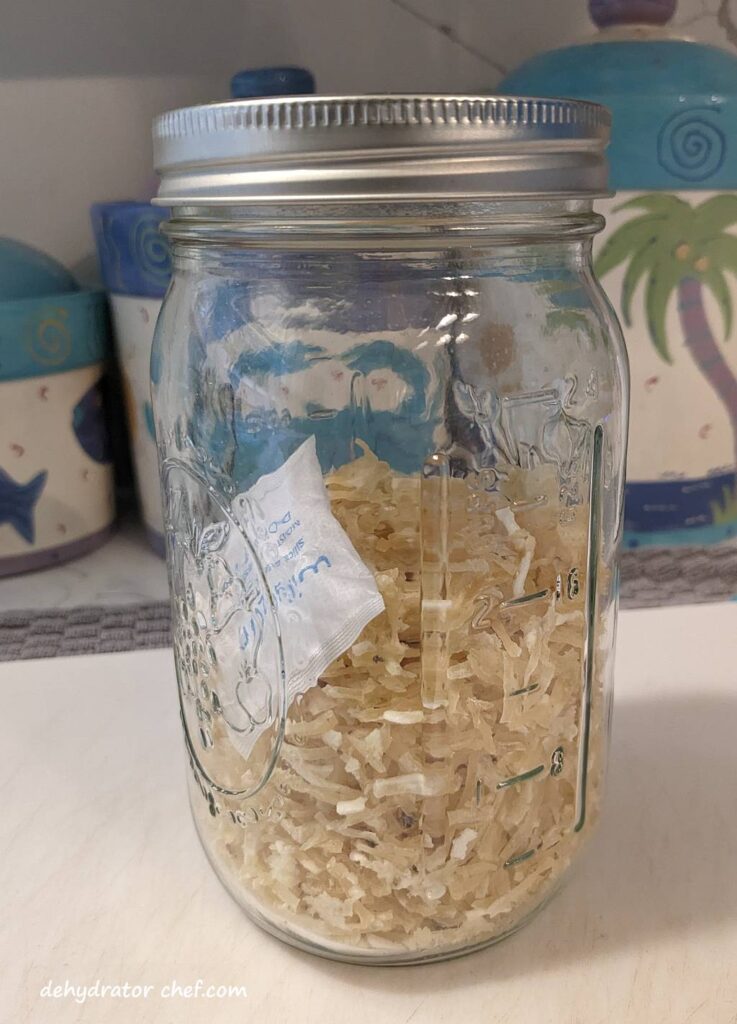
We’ll use a food-safe desiccant packet for moisture control because we live in a fairly humid area. For our pint-size or quart-size mason jars, we’ll use a single food-safe 5-gram desiccant packet. For larger jars, we’ll add 2 packets. The desiccant packets will absorb any moisture and help extend the shelf life of the dehydrated food.
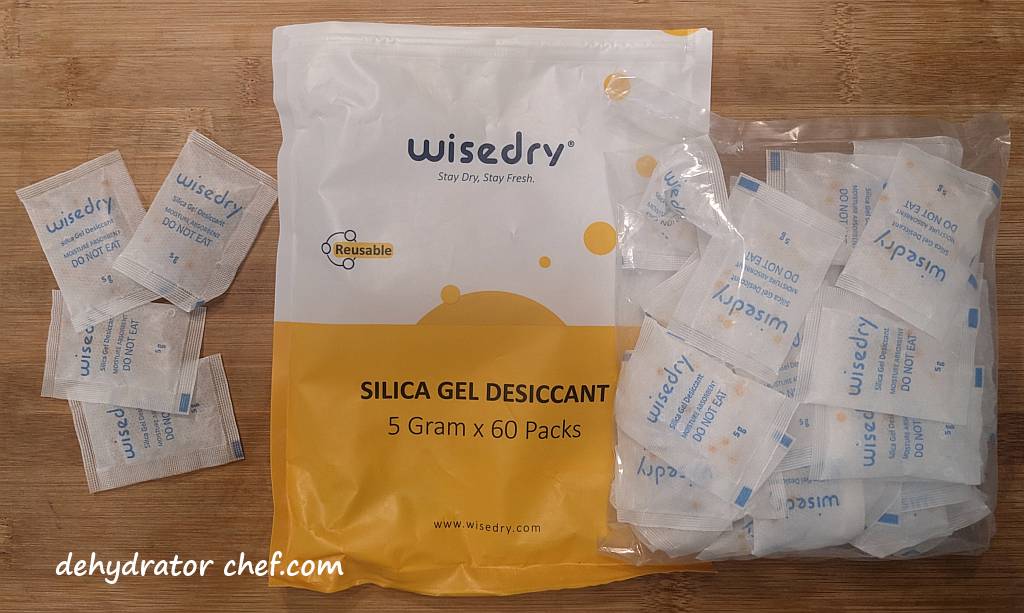
We use these inexpensive food-safe desiccant packets, which are available from Amazon. These 5-gram packets have over 5000 of mostly 4- and 5-star customer reviews, with an average of 4.7 stars out of 5. Our bag of 60 desiccant packets will last quite a while because they can be recharged and reused multiple times. Other food-safe sizes are available.
Lastly, attach or include a short note describing the jar contents and the date the product was dehydrated. The label identifies the canning jar contents, and the date helps with the rotation schedule. A first-in, first-out rotation helps us to use items that have been on the shelf the longest, so we’re using the oldest food first. This method helps us maintain the integrity of dehydrated products. The note also lets me know where to go in my dehydrator logbook if I want to make an update.
Hydration
Hydrate the dried hash browns using roughly a 1-to-1 ratio of dehydrated product to boiled water. Plan on at least 15 to 20 minutes to fully hydrate.
If you’re supplementing store-bought freeze-dried meals as we often do, just add a bit more boiling water to the food pouch. Use the same 1-to-1 ratio of dehydrated hash browns to water and account for the extra time. I find that most store-bought freeze-dried meals could use a little extra to bump up the calorie count, contents, or add more nutrition.
Weights, Measures, and Serving Sizes
A 30-ounce bag of frozen hash browns, about ten servings, will dehydrate to approximately 155 grams.
So, each serving of dehydrated hash browns is about 15 grams.
Dehydrated Hash Browns Nutrition Information
Serving Size: 15 grams | Calories: 60kcal | Total Fat: 0g | Saturated Fat: 0g | Cholesterol: 0mg | Sodium: 15mg | Carbohydrate: 15g | Dietary Fiber: 1g | Sugar: 1g| Protein: 2g
Insider Tips
Besides dehydrated meal recipes found here on this website, add dehydrated hash browns to any of your favorite freeze-dried food pouches for a bit more nutrition.
Just be sure to compensate by adding additional boiled water in roughly a 1-to-1 ratio of added dehydrated hash browns to boiling water to the freeze-dried meal and allow enough time for adequate hydration.
 | The Dehydrator Chef Book Available only on Amazon.com You’ll find step-by-step instructions for 26 homemade dehydrated camping meals. Many recipes are only available in this book. Grab yourself a copy today. |

How to Dehydrate Hash Browns
Equipment
- Removable mesh screen insert (one for each dehydrator tray)
- Common kitchen tools (including cutting boards, chef's knife, strainer, steamer basket, colander, can opener, etc.)
- Canning jars with tight-fitting lids
- Desiccant packets for moisture control (optional)
Ingredients
- frozen hash browns
Instructions
Process the Frozen Hash Brown Potatoes
- Working in batches, steam the frozen hash browns for approximately two minutes until they are just tender.frozen hash browns
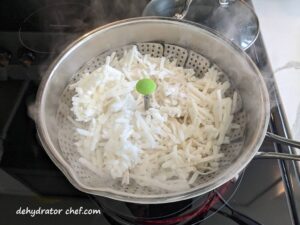
- Plunge the steamed hash browns into an ice water bath to stop the cooking process. Then drain.
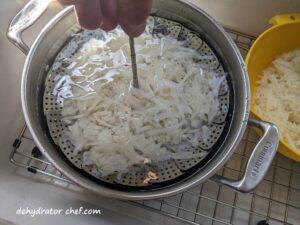
Prepare the Dehydrator
- Layer the hash browns onto the removable mesh screen inserts; one 30-ounce bag of frozen hash brown potatoes that are steam-cooked will fill two to three Nesco 13.5-inch round dehydrator trays.
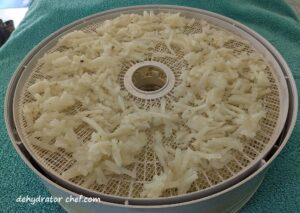
Dehydrate the Hash Brown Potatoes
- Set the dehydrator thermostat temperature to 135 °F (57 °C). Dry for 18 to 24 hours until done.
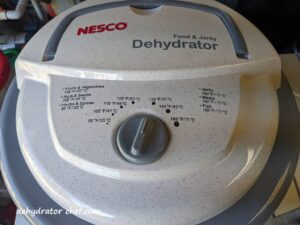
- Check on the hash browns every few hours and break apart the bigger pieces into smaller fragments to help prevent case hardening.
When are the Dehydrated Hash Brown Potatoes Done
- When done, the dehydrated hash browns will be crisp and brittle and will crumble into smaller pieces when crushed. There should be no wet or mushy pieces.
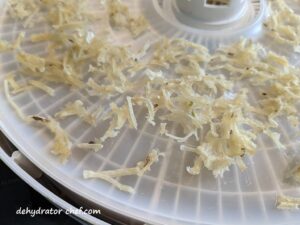
Equalizing and Conditioning Dehydrated Hash Brown Potatoes
- After a short cooling period, loosely pack the dehydrated hash browns into a clean, dry canning jar with a tight-fitting lid, leaving some headspace.
- Every day, for 7 to 10 days, check the jar for moisture. Roll the jar contents around and note any clumping or sticking. If seen, put it all back on the dehydrator for several more hours.
- If you notice any mold at all, even the slightest bit, throw it all out.
Storing the Dehydrated Hash Brown Potatoes
- Use appropriate-sized canning jars for storage. Depending on how well you dehydrate the hash browns and your pantry storage conditions, it should keep for at least 12 months.
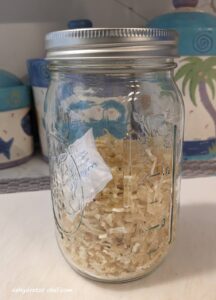
- An optional food-safe desiccant packet will aid with moisture control.

- Attach or include a label describing the jar contents and the date the product was dehydrated. The label identifies the canning jar contents, and the date helps with the rotation schedule. A first-in, first-out rotation helps us to use items that have been on the shelf the longest, so we're using the oldest food first.
Notes
Nutrition
Nutrition information is only an estimate and may differ depending on the ingredients you use.

One reply on “How to Dehydrate Hash Browns – Dehydrating Hash Browns, A Step-by-Step Guide”
This step-by-step guide on Dehydrator Chef for dehydrating hash browns is clear and practical. I appreciated how it emphasized using frozen hash browns for ease and offered straightforward tips for drying and storage. It’s especially useful me as I am looking for lightweight and shelf-stable options. The step-by-step breakdown made the process easy to follow without feeling overwhelming.